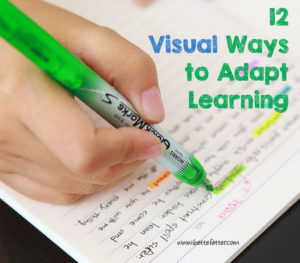12 Visual Ways to Adapt Learning
 Right brain, visual-spatial individuals are conceptual, non-linear thinkers and they often miss details, struggle with memorization and prefer images over words. We need to help our visual kids adapt school to their own learning style to improve academic outcomes.
Right brain, visual-spatial individuals are conceptual, non-linear thinkers and they often miss details, struggle with memorization and prefer images over words. We need to help our visual kids adapt school to their own learning style to improve academic outcomes.
Here are 12 simple ways to adapt learning for your visual child:
- Make learning visual. – When classroom material is presented visually, your visual student is already on their way to more successful studying. These learners remember images – not words.
- Write notes – The physical act of writing actually helps visual kids remember. Write very simple notes over and over again to help with remembering.
- Add Images – Along with writing words, have them add simple images to help trigger memory. This is great for vocabulary practice. Again, visual kids remember pictures – not words.
- Use color – Add color whenever you can. Encourage them to take notes in color. Write key words in color. Write on colored note cards. Use a highlighter to help ‘see’ key information.
- Make vocabulary colorful –To practice vocabulary words, write each word on a flashcard. Add an image. Use colored markers, or colored note cards. For longer words, take the learning even further by using a different color for each syllable.
- Make math tangible – Let kids see, touch and do when it comes to math. Use colorful tiles or chips so your child can ‘see’ and understand core concepts before they practice computation.
- Make room for creativity – Our visual kids need time in their day to let their big ideas flow. Allowing them to use their strengths only helps them retain the information they are trying to learn.
- Act it out – Some kids learn best by doing. When possible get away from the words and act out the information. Seeing the concepts 3-dimensionally can add clarity and improve memory.
- Draw it out – Help your child learn to use mind maps. These are like visual outlines or notes and help visual kids organize information and make memorizing easier.
- Record and listen – Some kids remember best when listening. Make a recording of the information they need to learn. Keep it simple. Let them listen to it over and over again, until they feel ready.
- Take art and music classes – Studies show that students who participate in the arts preform better on tests. The arts help them develop observation, patterning, differentiation and a host of other learning skills.
- Mix it up and repeat – Repetition is the key to remembering. So, keep it fresh by applying different techniques to the same material.
These learning techniques are great ways for visual kids to learn every day. Once you and your visual student learn to use these techniques, you’ll be able to adapt them to any subject matter and every age level.










